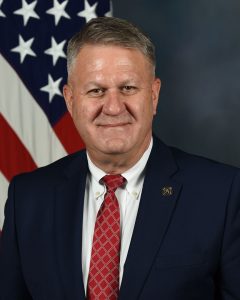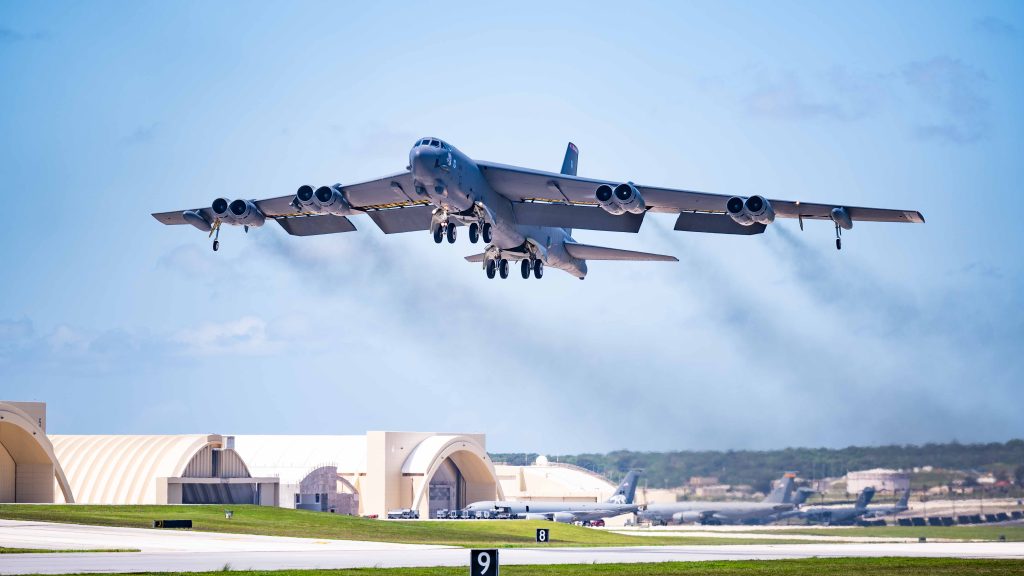
TARGET PRACTICE: Two U.S. Air Force B-52H bombers take part in a routine training event in 2022 at the Grafenwoehr Training Area in Germany, in support of NATO allies and regional partners. (Photo by Gertrud Zach, Training Support Activity Europe)
FROM THE DIRECTOR OF
ACQUISITION CAREER MANAGEMENT
RONALD R. RICHARDSON JR.

Ronald R. Richardson Jr., Director, U.S. Army Acquisition Support Center and Director, Acquisition Career Management
In 1954, the B-52 bomber took its inaugural flight. Today, 70 years later, the B-52 Stratofortress remains an integral part of the Air Force inventory, serving as a living example of adaptability and innovation.
What makes the B-52 so unique is that it was built to be modular and flexible. What makes it successful is that the people working on the program—both government and industry partners—have been agile and innovative in reimagining the aircraft throughout its life span. From new engines to a new radar, the B-52 is continuously updated with the warfighter in mind and a keen eye toward environmental sustainability.
This multifaceted approach positions the Stratofortress as more than just a military asset. It stands as an enduring symbol of adaptability, innovation and a steadfast commitment to a sustainable future.
WHAT IS SUSTAINABILITY
I was recently asked how I define sustainability. My response: “How do you define sustainability?” I responded that way because I bet we’d have different answers.
According to the Army Climate Strategy released in 2022, sustainability is defined as “the property of being environmentally sustainable; the degree to which a process or enterprise is able to be maintained or continued while avoiding the long-term depletion of natural resources.”
As acquisition professionals, we have a responsibility to consider environmental implications along with operational significance. Understanding the concept of sustainability is the first step toward purposeful action throughout the acquisition life cycle, from planning to design and production to disposal.
For example, American B-52s are receiving new engines that, according to the Air Force, will see 30% better fuel efficiency and eliminate the need for engine overhauls for the remainder of the aircraft’s expected life span. In addition to these benefits, Boeing, the industry partner responsible for designing and building the B-52, says the new engine also will have a positive environmental impact. Specifically, it will come with a significantly smaller carbon footprint—less than 5% of the footprint of the current engine. This demonstrates the importance of collaboration with our industry partners in achieving sustainability. In our strategic approach to acquisition and the integration of systems of systems, sustainability holds a pivotal role.
A shared understanding of sustainability is imperative and must be part of our decision-making process. If given a choice, we must always choose the sustainable option.

TAKING FLIGHT: A B-52 assigned to the 2nd Bomb Wing at Barksdale Air Force Base, Louisiana, takes off from Andersen Air Force Base in Guam, in support of a Bomber Task Force mission in April 2023. (Photo by Airman 1st Class William Pugh, Pacific Air Forces)
SUSTAINABILITY WITH PURPOSE
I’ve said in previous columns that we must ensure our Soldiers are never in a fair fight. Sustainability is a key tool in our toolkit to protect and serve our Soldiers.
For example, we can continue to increase power density in our storage batteries. But if we can also make our systems use less energy and become more efficient, it helps to reduce the Soldier’s load and extends the operational envelope. Finding ways to be more energy efficient can also result in returning money to the budget for a Soldier’s kit. But we can’t do this alone.
My top priority is always the Soldier. That is why, as the Army Director of Acquisition Career Management, I want to ensure all Army Acquisition Workforce professionals have information and training available regarding environmental sustainability and climate resilience so that we are doing our collective part. It’s important to understand that each of us has a role to play and an impact to make. From sourcing efficient capabilities that work well together and are themselves sustainably sourced, to leveraging materials that don’t create long-term negative environmental impacts, from efficiently utilizing operational energy to reduce demand on our systems, to recycling or upcycling used materials, every little thing we can do makes a difference.
We can set the baseline through upskilling.
UPSKILLING
In 2023, we focused additional training on digital transformation; 2024 is the year of sustainability.
As with digital transformation and digital literacy, our workforce must have fundamental literacy regarding sustainability. We must be able to have intelligent conversations about sustainability and articulate its benefits as part of our configuration management process. This shared understanding will help drive change, innovation and new ways of thinking.
| “I speak for the trees, for the trees have no tongues.”—Dr. Seuss, The Lorax |
CONCLUSION
The B-52—expected to remain in use beyond 2040 in the U.S.—remains a pinnacle of durability and flexibility in aviation and in the defense acquisition community. The U.S. still has more than 70 of these aircraft in its inventory, with 60 in use by both active and reserve units. The plane itself remains structurally sound while its avionics, flight hardware, and weapons and navigation systems have been upgraded over time. What’s made it successful is not just the original out-of-the-box thinking of its designers, but a commitment to ensuring its longevity in the inventory through the continuous incorporation of cutting-edge technology.
We must maintain the innovation mindset of the B-52 for our Army programs.
As part of the Back-to-Basics transition, we’re now placing greater emphasis on targeted learning and self-development that are driven by supervisors and employees themselves. I encourage you to take our recommended Udemy training, educate yourself, do the reading, put in the work and ultimately contribute to our ever-evolving mission, supporting our Soldiers, the Army, the nation and our planet.







